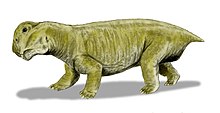Introduction.
Hibernation is a well-defined topic in the science world today. The scientists have studied all the different type of animals which
Practice hibernation. Basically, Hibernation is defined as the practice of getting through the winter months when there is less availability of food, and the days are dark with very low temperature.

New research by scientists has shown that this adaptation has been prevalent since the prehistoric times. The scientists at the University of Washington and the Burke Museum of Natural History and culture have written in the journal of Communications Biology. There they have explained the evidence of hibernation or hibernation-like the practice of an animal that lived in the region of Antarctica during the Triassic period which is about 250 million years ago.
That animal is known to have been a part of the family Lystrosaurus, which is said to be a very far relative of mammals. During the Triassic times, Antarctica was largely in the same region as today and experienced extreme weather conditions. The climate was mostly without sunlight and the winters were very dark.
Fossil evidence:
The oldest evidence is found in the fossil record that indicates a hibernation-like state. In the vertebrate animals, the torpor which was a practice related to hibernation, in which the animal is found to lower their metabolic rate during the extreme winter times was found. Even before the animals and the dinosaurs were evolving.
It has been an event habit for the animals living near the poles to adopt practices to overcome the climate. This was published in a research done by an author from Harvard research facility. This research and the articles indicate the state of hibernation to be a very old practice.
Lystrosaurus:
Lystrosaurus were contemporary to a very fast-moving time in the natural history of Earth. They were active just before the largest mass extinction was seen by the Earth. That wiped out 70% of the vertebrate population of Earth. The Lystrosaurus were the animals who survived this mass extinction, this makes them very interesting to research. They also had a very vast population during the Triassic period.
Paleontologists now days have also found the fossils of this animal in India, Russia, China, North Africa, and Antarctica. These creatures were basically the same size as of pig and about 7 feet long. There was an absence of teeth but two tusks which were mostly used for digging. Those tasks were very similar to the tusks of elephants and grew throughout their lives. These tusks were of great knowledge for scientists to determine almost every aspect of the lives of these animals.
This discovery is very important as it suggests that the survival practices of animals around the world can be traced back to prehistoric times.